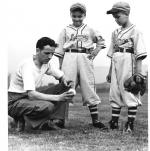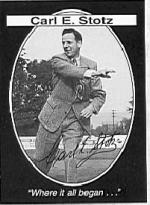![header=[Marker Text] body=[Founder of Little League Baseball and Commissioner through 1955. Stotz developed the Little League idea in 1938; in the next year three teams played 24 games. It was at this site that Stotz established field distances for the pre-teenage players. The first 12 Little League World Series were held on this field, 1947-1958, and during these years the number of teams grew from 60 to thousands in many nations.] sign](http://explorepahistory.com/kora/files/1/10/1-A-6-139-ExplorePAHistory-a0a0d4-a_450.gif)
Mouse over for marker text
Name:
Carl E. Stotz
Region:
Valleys of the Susquehanna
County:
Lycoming
Marker Location:
Original Little League Field, W. 4th St., Williamsport
Dedication Date:
October 10, 1995
Behind the Marker
In August of 1938, Williamsport native Carl Stotz was playing catch in his backyard on Isabella Street with his nephews Jimmy and Major. Across the nation, in communities like Williamsport, boys couldn't wait to get home from school, pick up their gloves, their bats, and their fraying balls, then head to the backyard or nearest sandlot, measure out a diamond, choose sides, and play the game. If they lived in a town as big as Williamsport, there might even be a graceful bandbox like  Bowman Field near by, where they could watch the bigger boys of the semi-pro and minor leagues play on a well-maintained field with foul lines, real bases, and an official umpire to call balls and strikes.
Bowman Field near by, where they could watch the bigger boys of the semi-pro and minor leagues play on a well-maintained field with foul lines, real bases, and an official umpire to call balls and strikes.
On that August afternoon, Major tossed one wildly past his uncle. Stotz took off after the errant throw, and scraped his ankle badly on a trimmed-down lilac bush. He hobbled to the porch and sat down. As his nephews approached, Stotz had his epiphany. "That's when I said to them," he recalled years later, "How would you like to play on a regular team, with uniforms, a new ball for every game and bats you could really swing?" And they said, ‘Who would we play? Will people come to watch us? Do you think a band would ever come to play?' "
So the idea of Little League baseball, Stotz's most important baseball dream, was born. And this seemingly too-good-to-be-true saga of the founding of Little League baseball is absolutely true - unlike the story of Abner Doubleday's invention of baseball.
For most of the nineteenth century, Americans had no problem accepting the idea that baseball -like America itself - had evolved from games and pastimes that began elsewhere. By the end of the century, though, the game's hierarchy had grown jingoistic. Intent on showing that the National Pastime had blossomed from a uniquely American seed, Albert G. Spalding, a former player, team owner, publisher, and sporting goods magnate, formed a commission that included Phillies owner Al Reach to unearth the game's origins. Its findings, published in 1908, insisted that baseball was wholly invented in 1839 by Abner Doubleday in Cooperstown, N.Y. Baseball's new, official history was off and running. Despite evidence pointing to its inaccuracy, the Creation Myth was so appealing and so fiercely marketed from the start that Cooperstown eventually became the game's "Eden" and Doubleday its American "Adam."
Al Reach to unearth the game's origins. Its findings, published in 1908, insisted that baseball was wholly invented in 1839 by Abner Doubleday in Cooperstown, N.Y. Baseball's new, official history was off and running. Despite evidence pointing to its inaccuracy, the Creation Myth was so appealing and so fiercely marketed from the start that Cooperstown eventually became the game's "Eden" and Doubleday its American "Adam."
There is no doubt, however, about the origins of Little League baseball. After his backyard tangle with the lilac bush, Carl Stotz devoted himself to that idea. Scouring Williamsport for potential sponsors, Stotz was turned down by sixty businesses before he enlisted Lundy Lumber, Lycoming Dairy, and Jumbo Pretzel to sponsor and outfit a trio of teams. On June 6, 1939, the first official Little League game was played about 300 yards from the Stotz house on the site now known as Original Little League Field.
By 1946, Little League had expanded to twelve leagues throughout Pennsylvania. The following year, Little League baseball crossed the border into its second state, New Jersey. Two years later, Stotz became the league's full-time commissioner, a position he held until 1956, when he left in a dispute with the board. Interestingly, Stotz, the father of two daughters, was adamantly opposed to allowing girls into the program. But from the beginning, he insisted that Little League be racially integrated, a decision that for years excluded Southern teams from the fold.
Stotz died in Williamsport in 1992. Today, Little League is played by some three million pre-teen boys and girls in all fifty states and 105 countries, and the talents of thousands of future Major leaguers have been honed in its programs. Every August, the sixteen best teams in the world converge on Little League Baseball International headquarters in South Williamsport to play the annual Little League World Series -on perfect diamonds, before thousands of fans, in games televised around the globe.
As for Carl Stotz's lilac bush, its remains are carefully preserved in the small museum adjacent to the Original Little League Field.
On that August afternoon, Major tossed one wildly past his uncle. Stotz took off after the errant throw, and scraped his ankle badly on a trimmed-down lilac bush. He hobbled to the porch and sat down. As his nephews approached, Stotz had his epiphany. "That's when I said to them," he recalled years later, "How would you like to play on a regular team, with uniforms, a new ball for every game and bats you could really swing?" And they said, ‘Who would we play? Will people come to watch us? Do you think a band would ever come to play?' "
So the idea of Little League baseball, Stotz's most important baseball dream, was born. And this seemingly too-good-to-be-true saga of the founding of Little League baseball is absolutely true - unlike the story of Abner Doubleday's invention of baseball.
For most of the nineteenth century, Americans had no problem accepting the idea that baseball -like America itself - had evolved from games and pastimes that began elsewhere. By the end of the century, though, the game's hierarchy had grown jingoistic. Intent on showing that the National Pastime had blossomed from a uniquely American seed, Albert G. Spalding, a former player, team owner, publisher, and sporting goods magnate, formed a commission that included Phillies owner
There is no doubt, however, about the origins of Little League baseball. After his backyard tangle with the lilac bush, Carl Stotz devoted himself to that idea. Scouring Williamsport for potential sponsors, Stotz was turned down by sixty businesses before he enlisted Lundy Lumber, Lycoming Dairy, and Jumbo Pretzel to sponsor and outfit a trio of teams. On June 6, 1939, the first official Little League game was played about 300 yards from the Stotz house on the site now known as Original Little League Field.
By 1946, Little League had expanded to twelve leagues throughout Pennsylvania. The following year, Little League baseball crossed the border into its second state, New Jersey. Two years later, Stotz became the league's full-time commissioner, a position he held until 1956, when he left in a dispute with the board. Interestingly, Stotz, the father of two daughters, was adamantly opposed to allowing girls into the program. But from the beginning, he insisted that Little League be racially integrated, a decision that for years excluded Southern teams from the fold.
Stotz died in Williamsport in 1992. Today, Little League is played by some three million pre-teen boys and girls in all fifty states and 105 countries, and the talents of thousands of future Major leaguers have been honed in its programs. Every August, the sixteen best teams in the world converge on Little League Baseball International headquarters in South Williamsport to play the annual Little League World Series -on perfect diamonds, before thousands of fans, in games televised around the globe.
As for Carl Stotz's lilac bush, its remains are carefully preserved in the small museum adjacent to the Original Little League Field.






